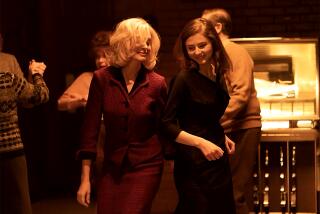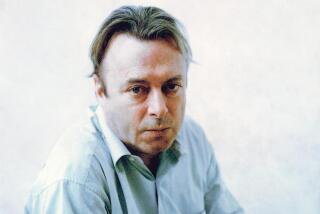A Rip-Roaring Look at ‘Hemingway’
- Share via
“Hemingway” is a movable feast.
Swilling, melodramatic promos for this six-hour number (“From tender moments . . . to violent goodbys (Stacy Keach as . . . HEMINGWAY!”) promise an overcooked biography that strips back fact to discover fantasy.
Not at all, actually. The two-part story--airing at 8 tonight and next Tuesday on KCOP Channel 13--is as warm and clean and friendly and descriptive as a Hemingway sentence on a wild, cold, blowing day when the leaves lie sodden in the rain and the windows mist over from the heat and the steam inside.
I saw the syndicated “Hemingway” in the evening as my wife slept sweetly with the moonlight on her face. Los Angeles was a very old city, and we were middle aged and nothing was simple there, not even poverty, nor sudden money, nor the moonlight, nor right and wrong nor the breathing of someone who lay beside you in the moonlight.
Yes, well, cheap parody is tempting when a writer as acutely distinctive as Ernest Hemingway is at hand. Happily, that is exactly what Keach and this lusty, rip-roaringly good miniseries avoid.
Dramatizing the life of a complex writer is particularly challenging, for the process of writing is lonely, interior and seldom dramatic. Moreover, the central Hemingway is inevitably obscured by a thick crust of celebrity. He was almost as famous an adventurer as writer, and his name has become synonymous with romance and excitement.
Based on “Ernest Hemingway--Collected Letters 1917-1961” and Carlos Baker’s “Ernest Hemingway: A Life Story,” this robust new production explores the writer by trying to define the man. Its tall stories are the tall stories of Hemingway’s epic life, a cumulative merging of self-destructive reality and self-perpetuated legend.
This is neither pop Hemingway nor definitive Hemingway, falling somewhere between as a middle-minded, highly appealing, well-acted and grandly and credibly staged sampling of a fascinating odyssey that yielded important writing.
Although frequently faulted by critics for his arid periods, Hemingway did produce a significant body of work. In this account, though, his writing is eclipsed by his characterization.
Keach’s Hemingway is seethingly on center, a literary wide body of brawn, charisma, energy and conflicts: tender and bullying, generous and predatory, self-doubting and self-inflating, tormented and tormenting, heroic and horrific, charming and overbearingly churlish, an anti-intellectual who was also bookish.
Here is Hem at his Hemiest, with Bernhard Sinkel’s script (he also adroitly directs “Hemingway”) covering a lifetime of fighting wars and private demons. Hemingway emerges with flaws and enigmas intact, seductive, but infuriating, steeped in booze and women, the macho sportsman and hunter who enjoyed killing and ultimately used a shotgun to bequeath himself the same “sweet death” he had delivered to so many magnificent animals.
The pitiful soul we first meet tonight is in mental, physical and literary decline, depressed, and unable to write, near the end, recalling his adult life beginning with his marriage to Hadley Richardson, with whom he shares the “movable feast” of Paris as a young man.
One by one, his fellow literati from the early days emerge in flashback: Sherwood Anderson, Gertrude Stein, Ezra Pound, John Dos Passos. The young writer subsists in Paris at Sylvia Beach’s famed bookstore and is driven by talent, ambition and intense envy--”that feeling you get when you’re better than the other guy and he’s always getting all the breaks.”
Sinkel creates pace without skimming or pandering, as we meet the real-life places and people of Hemingway’s novels, including his four superbly played wives: matronly Hadley (Josephine Chaplin), exotic Pauline Pfeiffer (Marisa Berenson), war-hopping Martha Gellhorn (Lisa Banes) and enduring Mary Welsh (Pamela Reed). Here, too, are Harold Loeb and the intriguing Lady Duff Twysden, Hemingway’s models for Robert Cohn and Lady Brett in “The Sun Also Rises.” And here is Hemingway running with bulls in Pamplona and feeding his bravado--along with our romantic images of war correspondents--while covering the Spanish Civil War and World War II.
Key West is here, along with Madrid, Africa, Italy and Ketchum, Ida., where in 1961, like his father before him, Hemingway took his own life. Suicide, a recurring theme in his writing, became his reality.
His last seemingly dazed, confused days, an especially sad period of despair and paranoia for him, are movingly depicted here. The gaze is vacant, the air gone from the balloon, a tragic end for a man so full of life . . . and death.
More to Read
The complete guide to home viewing
Get Screen Gab for everything about the TV shows and streaming movies everyone’s talking about.
You may occasionally receive promotional content from the Los Angeles Times.






